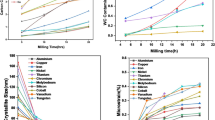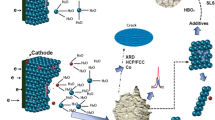Abstract
The solid-phase synthesis of LiFeO2 lithium ferrite from mechanically activated Fe2O3–Li2CO3 initial reagent mixtures was investigated by X-ray powder diffraction and thermal analysis techniques. The mechanical milling of powder mixture was carried out by AGO-2S planetary ball mill with a rotation speed of 2220 rpm for 60 min. According to the XRD data, the crystallite sizes of milled reagents decrease as a result of ball milling. From thermal analysis, it was shown that the ferrite synthesis starts with the interaction between reagents and lithium carbonate decomposition and accompanied by mass loss process due to CO2 evaporation. For non-milled mixtures, the mass loss process occurs in the temperature range 400–740 °C and comprises two steps. As for milled samples, this process shifts toward lower temperatures, where a slight mass loss process is observed from 100 °C up to 400 °C, while the main mass loss occurs in the temperature range of 400–550 °C in one stage. The results indicate that the major mechanism of solid-state reaction can be attributed to the two-step model of the reaction proceed, whose rate is diffusion controlled over the entire temperature range for non-milled mixture, but corresponds to the diffusion and n-order equation depending on conversion degree for milled mixture. Generally, a preliminary mechanical activation of Fe2O3–Li2CO3 considerably enhances the reactivity of the solid-phase system, thereby reducing the temperature of lithium ferrite thermal synthesis. Thus, LiFeO2 ferrite can be obtained from reagents mixture mechanically activated for 60 min at temperature of 600 °C for 2 h, that is, at a significantly lower synthesis time and temperature than in the case of using conventional solid-state synthesis from non-milled reagents.









Similar content being viewed by others
References
Sakurai Y, Arai H, Okada S, Yamaki J. Low temperature synthesis and electrochemical characterization of LiFeO2 cathodes. J Power Sources. 1997;68:711–5.
Dahn JR, Von Sacken U, Michal CA. Structure and electrochemistry of Li1 ± yNiO2 and a new Li2NiO2 phase with the Ni(OH)2 structure. Solid State Ion. 1990;44:87–97.
Sakurai Y, Arai H, Yamaki J. Preparation of electrochemically active α-LiFeO2 at low temperature. Solid State Ion. 1998;113–115:29.
El-Shobaky GA, Ibrahim AA. Solid-solid interactions between ferric oxide and lithium carbonate and the thermal stability of the lithium ferrites produced. Thermochim Acta. 1987;118:151–8.
Rakshit SK, Parida SC, Naik YP, Venugopal V. Thermodynamic studies on lithium ferrites. J Solid State Chem. 2011;184:1186–94.
Surzhikov AP, Pritulov AM, Lysenko EN, Vlasov VA, Vasendina EA, Malyshev AV. Analysis of the phase composition and homogeneity of ferrite lithium-substituted powders by the thermomagnetometry method. J Therm Anal Calorim. 2013;112:739–45.
Teixeira SS, Graça MPF, Costa LC. Dielectric, morphological and structural properties of lithium ferrite powders prepared by solid state method. J Noncryst Solids. 2012;358:1924–9.
Randhawa BS, Dosanjh HS, Kumar N. Synthesis of lithium ferrite by precursor and combustion methods: a comparative study. J Radioanal Nucl Chem. 2007;274:581–91.
Verma V, Pandey V, Aloysius RP, Annapoorni S, Kotanala RK. Comparative study of structural and magnetic properties of nanocrystalline Li0.5Fe2.5O4 prepared by various methods. Phys B. 2009;404:2309–14.
Aravind G, Raghasudha M, Ravinder DM, Manivel R, Meena SS, Bhatt P. Study of structural and magnetic properties of Li–Ni nanoferrites synthesized by citrate-gel auto combustion method. Ceram Int. 2016;42:2941–50.
Tabuchi M, Ado K, Sakaebe H, Masquelier C, Kageyama H, Nakamura O. Preparation of AFeO2 (A = Li, Na) by hydrothermal method. Solid State Ion. 1995;79:220.
Berbenni V, Bruni G, Milanese C, Girella A, Marini A. Synthesis and characterization of LaFeO3 powders prepared by a mixed mechanical/thermal processing route. J Therm Anal Calorim. 2017. https://doi.org/10.1007/s10973-017-6878-z.
Parlak TT, Apaydin F, Yildiz K. Formation of SrTiO3 in mechanically activated SrCO3–TiO2 system. J Therm Anal Calorim. 2017;127:63–9.
Mihalache V. Thermal analysis of ball-milled Fe–14Cr–3 W–0.4Ti–0.25Y2O3 ferritic steel powder. J Therm Anal Calorim. 2016;124:1179–92.
Berbenni V, Marini A, Matteazzi P, Ricceri R, Welham NJ. Solid-state formation of lithium ferrites from mechanically activated Li2CO3–Fe2O3 mixtures. J Eur Ceram Soc. 2003;23:527–36.
Widatallah HM, Johnson C, Berry FJ. The influence of ball milling and subsequent calcination on the formation of LiFeO2. J Mater Sci. 2002;37:4621–5.
Kavanlooee M, Hashemi B, Maleki-Ghaleh H, Kavanlooee J. Effect of annealing on phase evolution, microstructure, and magnetic properties of nanocrystalline ball-milled LiZnTi ferrite. J Electron Mater. 2012;41:3082–6.
Gee SH, Hong YK, Park MH, Erickson DW, Lamb PJ. Synthesis of nanosized (Li0.5xFe0.5xZn1−x)Fe2O4 particles and magnetic properties. J Appl Phys. 2002;91:7586–8.
Widatallah HM, Ren XL, Al-Omari IA. The influence of TiO2 polymorph, mechanical milling and subsequent sintering on the formation of Ti-substituted spinel-related Li0.5Fe2.5O4. J Mater Sci. 2006;41:6333–8.
Surzhikov AP, Lysenko EN, Malyshev AV, Pritulov AM, Kazakovskaya OG. Influence of mechanical activation of initial reagents on synthesis of lithium ferrite. Russ Phys J. 2012;6:672–7.
Surzhikov AP, Lysenko EN, Vlasov VA, Malyshev AV, Nikolaev EV. Thermal analysis study of solid-phase synthesis of zinc- and titanium-substituted lithium ferrites from mechanically activated reagents. J Therm Anal Calorim. 2015;122:1347–53.
Brown ME, Dollimore D, Gallway AK. Reaction in solid state. Comprehensive chemical kinetics. Amsterdam: Elsevier; 1980.
Opfermann J. Kinetic analysis using multivariate non-linear regression. J Therm Anal Calorim. 2000;60:641–58.
Moukhina E. Determination of kinetic mechanisms for reactions measured with thermoanalytical instruments. J Therm Anal Calorim. 2012;109:1203–14.
Sharma P, Uniyal P. Investigating thermal and kinetic parameters of lithium titanate formation by solid-state method. J Therm Anal Calorim. 2017;128:875–82.
Lysenko EN, Nikolaev EV, Surzhikov AP. TG study of the Li0.4Fe2.4Zn0.2O4 ferrite synthesis. IOP Conf Series. Mater Sci Eng. 2016;110:012092.
Friedman HL. Kinetics of thermal degradation of char-forming plastics from thermogravimetry. Application to a phenolic plastic. J Polym Sci Part C. 1964;6:183–95.
Acknowledgements
This work was supported by the Ministry of Education and Science of the Russian Federation in part of the Science Program (Project 11.980.2017/4.6). The experiments on equipments and participation in scientific conference were funded from Tomsk Polytechnic University Competitiveness Enhancement Program Grant.
Author information
Authors and Affiliations
Corresponding author
Rights and permissions
About this article
Cite this article
Lysenko, E.N., Surzhikov, A.P., Nikolaev, E.V. et al. Thermal analysis study of LiFeO2 formation from Li2CO3–Fe2O3 mechanically activated reagents. J Therm Anal Calorim 134, 81–87 (2018). https://doi.org/10.1007/s10973-018-7113-2
Received:
Accepted:
Published:
Issue Date:
DOI: https://doi.org/10.1007/s10973-018-7113-2




